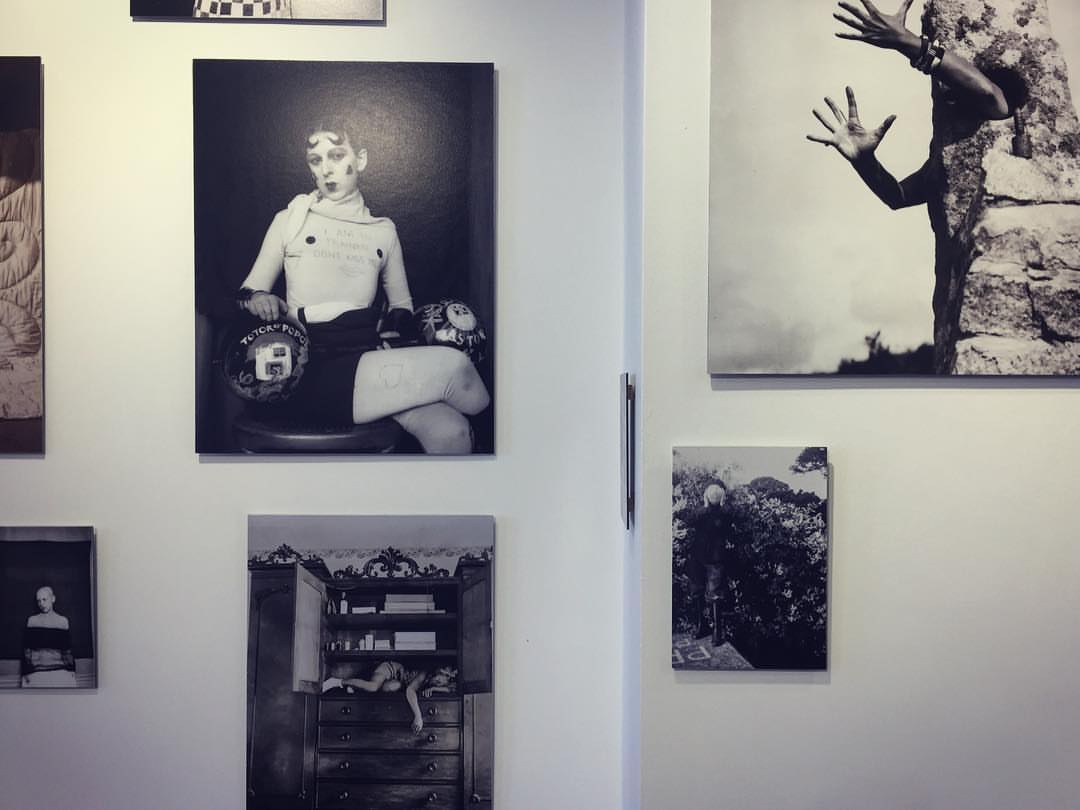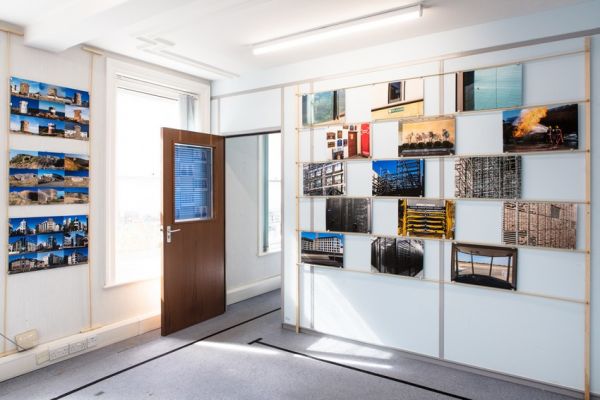In what way can the work of Lewis Bush and Clare Rae both be considered political?
Recently along with fellow photography students I visited Lewis Bush’s ‘Trading Zones’ exhibition and Clare Rae’s ‘Entre Nous’ exhibition in response to the late photographer Claude Cahun. Now the work that makes up both of these exhibitions is definitely something that can strongly be considered as political. How so is what takes some explaining.

Trading Zones Exhibition
Room 1
My initial thoughts and feelings on the work of these 3 photographers from the exhibitions that we visited was not that the work stood out as particularly political, instead I was just intrigued and taken by how visually interesting and conceptual the images being displayed were. It was immediately clear with the Entre Nous exhibition that both Clare Rae and Claude Cahun’s work had obvious visual links and similarities, a running theme somewhat; however after initially being exposed to Lewis Bush’s Trading Zones exhibition, his works didn’t all share a similar visual theme or aesthetic and instead they were more in sets or projects under one overhead theme of the finance industry. Despite this, after looking into all 3 of these photographers’ work in terms of the exhibitions in much more depth, it was very evident that each of their collated works had a strong political theme / issue running throughout.

Entre Nous Exhibition
CCA Gallery
(Work of Claude Cahun)
In order to get a good enough understanding of where each of the photographers’ work is coming from it would only be right to take a brief look at the background of the three photographers…
Lewis Bush is a photographer, writer and educator, born in London in the year 1988. With a Master’s degree in documentary photography, he is a lecturer of photojournalism and documentary photography at London College of Communication (LCC.) His main beliefs and aims of his photography are “to draw attention to forms of invisible power that operate in the world” believing that “power is always problematic” because it is inherently “arbitrary and untransparent.” This says a lot about how Lewis Bush approaches photography in a documentary fashion, with a strong belief on the topic of power and how that is effective upon society and people individually. Specifically looking at his Trading Zones Exhibition which was located at the old police station in the royal square of St Helier, that took place in September. This was a body of work which was a result of Lewis Bush’s time as a photographer in residence at the Societe Jersaise in Jersey, exploring different aspects and topics surrounding the theme of finance.

Clare Rae is a photographer / artist who is based in Melbourne, Australia, who completed a Master of Arts by research in 2014 at Monash University, and received first class Honours in Fine Art in 2009 at RMIT University. Her approach to photography is very unorthodox as she experiments with performance and the use of her own body and figure as a subject of the images which she produces. ” Her work is informed by feminist theory, and presents an alternate and often awkward experience of subjectivity and the female body.” One of Rae’s main interests within her individual practice of performance photography is how ”the camera can act as a collaborator, rather than mute witness, to the performer.” As a self-proclaimed artist as well as being a photographer, this incorporation of performance within her photography is something which could be considered as a more artistic than photographic matter, in terms of lens based imagery. Specifically looking at Clare Rae’s work from the Entre Nous exhibition, this was a response to the work of Jersey based photographer Claude Cahun who explored similar themes and issues, predominantly that of feminism and gender stereotypes, within her work. Although the photographic practices or these two photographers are separated by 70 years they have a lot of similarities. Claude Cahun was an avant-garde artist and writer, who in the 1920s, was associated with a creative movement known as the Parisian surrealist movement. She was not a stereotypical citizen of Jersey, and probably still wouldn’t be classed as one to this day. She was a lesbian who was in a relationship with her half sister, she was also Jewish and she was activist who protested against the German occupation. To sum up the effects of her work ”Cahun’s subversive self-portrait photographs and texts have become highly influential for artists dealing with questions of gender identity and representation of the female body.”

In terms of how Lewis Bush and Clare Rae’s work is considered political, it is very evident after looking at their photographic intentions and ideas that they both cover very political matters within society. Although very different matters, they are certainly political, Bush’s being that of the finance industry which is very intertwining with politics, and Rae’s being that of feminism, equality and gender stereotypes which are also very politically discussed topics. These are political matters that all effect society somewhat in positive ways, and on the other hand sometimes not so much.
Bush covered various aspects of what finance actually is, specifically on the island of Jersey. These aspects showed different ways in which finance can be perceived, used and thought about by society. He approached the project in a very modern and experimental manner, with a range of subjects and topics linked to finance, whilst not going overboard with the experimentation, in order to not create too much abstraction. He used a wide range of archival imagery within the exhibition in his own way in order to help display his findings and interests that he found along the way of completing the project. One of the most interesting parts of the exhibition was the fact that he had made part of it interactive. Allowing visitors of the exhibition (members of the general public) to create there own response to the words ”Finance Is…” On cards that were attached to part of the exhibition. This allowed for people’s views and opinions on the topic of the exhibition to be expressed and viewed by others. Overall I believe that Bush’s exhibition was very successful at portraying the finance industry for what it is in a visual way.

In contrast to Lewis Bush’s work Clare Rae’s approach to her work that made up the Entre Nous exhibition was more contemporary, and has more of a discreet and hidden meaning. Although we are aware that her work covered topics such as feminism and gender stereotypes, the imagery displayed in the exhibition is fairly open for interpretation as it is making the audience/viewer have to think about what each individual image is trying to portray. One of the main and most blatantly obvious visual differences between Bush and Rae’s work is that Rae’s photographs are monochrome, this may be in order to remove any distractions or false meanings that could be caused by the use of colour. Overall I believe that Clare Rae executed a very impressive exhibition which was a great response to the work of the surrealist photographer Claude Cahun and the topics surrounding her work.
Behind The Scenes Of Entre Nous Claude Cahun & Clare Rae
In conclusion it is very evident to me that both Lewis Bush and Clare Rae’s work can be considered as political, as they both cover extremely political matters specifically within the two projects of work which they have recently exhibited.
(The sources that I have used for information are linked throughout this post in blue.)

Charlie: this is well written, and you seem to have understood the essence of what both photographers have achieved with their worK.
Aim to develop a more substantial conclusion….that refers to the question nut also encapsulates your argument / hypothesis.